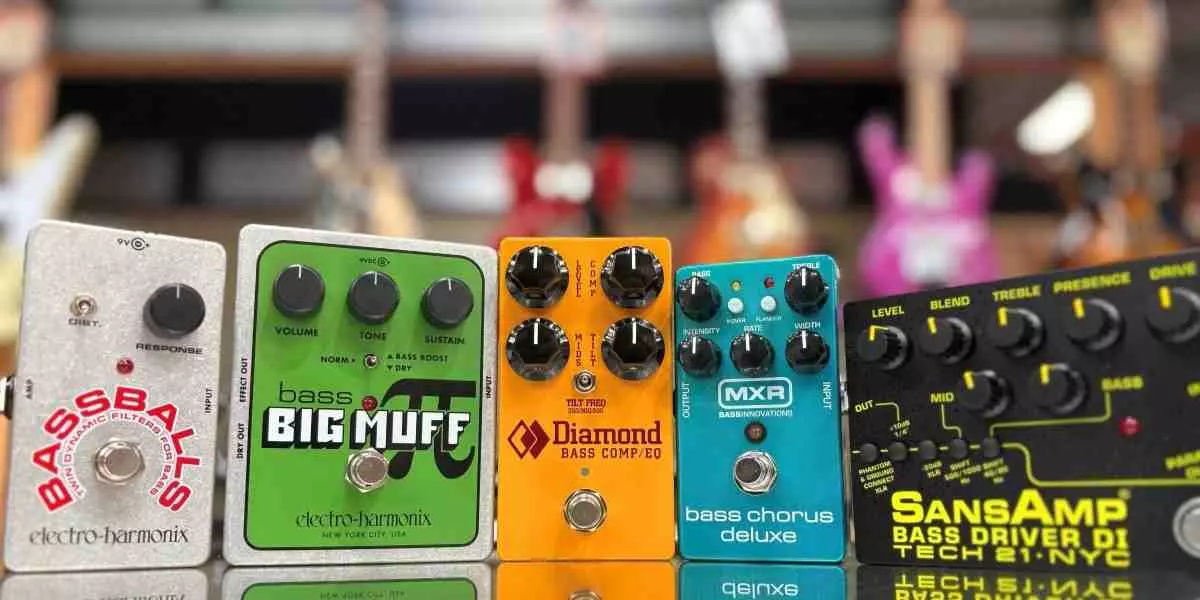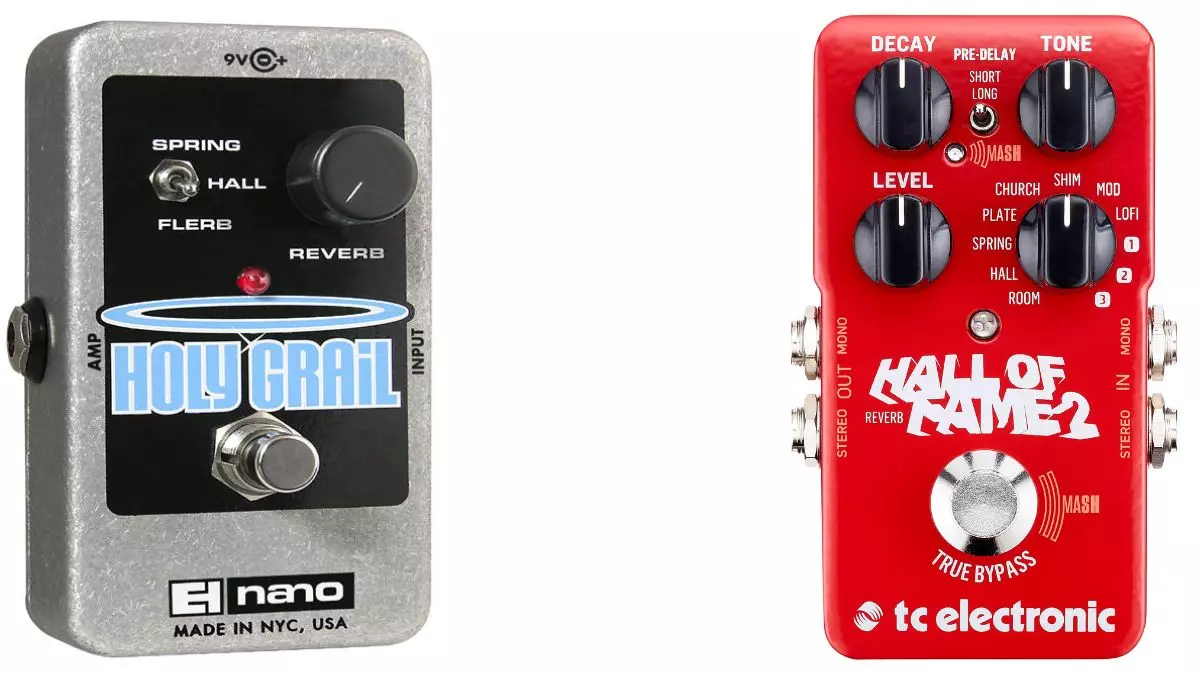The Essentials of Bass Effects

Last Updated: November 25, 2025
For a long time, effect pedals were seen as something only guitarists used. Since the introduction of the Maestro Fuzz Tone in 1962, guitarists have used stompboxes to create mind-blowing effects that sound wondrous, edgy, and dreamy.
Nowadays, bass players have their own set of tools to expand their rig and broaden their tones. Bass pedals offer bassists a variety of ways to shape their sound and stand out in any band or recording.
This guide will explore the most popular types of bass effect pedals and offer recommendations for beginners and experts alike. Whether you're just starting your pedal journey or looking to expand your collection, there’s something here for everyone.
Compression Pedals
Compression is an effect that helps smooth out your playing by controlling the volume of your notes. As the name implies, it smooths the highs and lows into one consistent sound by making quiet notes louder and loud notes quieter.
For an affordable and straightforward pedal, the Electro-Harmonix Bass Preacher is a great starting point for beginners who want to explore compression without breaking the bank.
Some bass players find it hard to hear what compression does at first. The MXR M87 Bass Compressor and the BOSS BC-1X Bass Comp feature displays to help fine-tune your sound with more precision. You'll notice the difference it makes in your overall sound.
The Electro-Harmonix Bass Preacher, MXR M87 Bass Compressor and the BOSS BC-1X Bass Comp (left to right)
Octave Pedals
An octave pedal takes the original signal, creates a copy, and shifts its frequency up or down to match the note being played. This can make your bass sound bigger and fuller, adding depth to your music. Some octave pedals generate multiple signals, allowing custom configurations such as one-up, one-down, or 2 octaves up or down.
Octave pedals are available in analog and digital forms, each with its own benefits. Analog pedals have a warm, natural sound, while digital pedals are better at tracking long notes and chords.
The Sub 'N' Up mini octave pedal by TC Electronic is an excellent bargain pedal for a beginner and occupies little real estate on a pedal board. It features a polyphonic octave algorithm for modern sounds, and you can use the TonePrint app to hone in on your pitch.
The EHX Micro POG is great at tracking notes and presents a lot of functionality in a simple package. The Micro POG gives the user three parameters to adjust: dry signal, octave down, and octave up, making it a great choice for bassists.
The Sub 'N' Up mini octave pedal and the EHX Micro POG
Overdrive/Distortion/Fuzz Pedals
Overdrive, distortion, and fuzz pedals alter the sound tone by adding varying levels of gain, but they all do it slightly differently. Used correctly, they can help fill out the sonic landscape of the mix or highlight a scorching hot solo. Here is a breakdown of their differences:
Overdrive pedals simulate the sound of a tube amplifier. They offer an aggressive boost, with a dynamic and smooth distortion that sounds 'dirtier' the harder you play. You can use them to create anything from a light crunch to full-on, face-melting distortion. The EHX Bass Soul Food is an affordable pedal that sounds fantastic and offers a warm, smooth overdrive.
Distortion pedals provide a heavier, more intense sound that, when compressed, creates a constant gritty effect. These effects are great for rock, punk, and metal bass players. The One Series Aftershock Bass by Source Audio is a well-reviewed distortion pedal featuring three bass distortion engines and connects to Neuro (a free mobile app) for additional tones.
Fuzz pedals offer the most extreme form of distortion, transforming your signal into a heavily saturated sound. The tone becomes thick, with lots of sustain and fuzzy texture, hence the name. The EHX Bass BigMuff is an affordable pedal that delivers great low-end fuzz, with different modes that keep the bass signal clean.
Merging a fuzz effect with the above effects can produce a unique synth sound similar to a synth pedal. Some devices integrate these two effects into a single compact unit. This approach saves money on effects and conserves space on the pedalboard, as engineers designed these two effects to complement each other. The Fulltone Octafuzz pedal is a prime example of such a unit.
The EHX Bass Soul Food, the One Series Aftershock Bass, and the EHX Bass BigMuff (left to right)
Chorus/Flanger/Phaser Pedals
In the bass world, Chorus pedals are more common than Flanger and Phaser pedals, but they all function similarly. Modulation effects like chorus, flanger, and phaser add depth and movement to your sound, as if multiple instruments were playing simultaneously. It works similarly to an octave pedal; it takes the original signal, copies it, and alters the pitch and timing.
The BOSS CEB-3 Bass Chorus is favoured amongst bassists, alongside the MXR M83 Bass Chorus Deluxe. They feature a warm, smooth, chorusing effect, and a good variety of controls to sculpt out your sound.
The TC Electronic Afterglow Chorus is a great budget pedal that isn't explicitly designed for the bass but will do in a pinch. It features an all-analog circuit to create a wide range of modulation tones and is highly reviewed for its reasonable price.
The BOSS CEB-3 Bass Chorus, the MXR M83 Bass Chorus Deluxe, and Afterglow Chorus (left to right)
Synthesizer Pedals
Synthesizer pedals let you create unique, futuristic sounds with your bass from short, punchy sub-bass to long, grinding swells. Each pedal offers a distinctive character and sound, so it's not uncommon for bassists to own more than one synthesizer pedal. If you’re into electronic music or want to add a synth-like vibe to your playing, this is the effect for you.
The EHX Bass Micro Synthesizer is a pure bass guitar synthesizer with all analog circuitry. With 10 adjustable parameters, this pedal offers a huge range of synth sounds. While it is a little more expensive than some competitors, the quality and flexibility it offers make it a must-have for experienced musicians.
The EHX Bass Micro Synthesizer is a pure bass guitar synthesizer with all analog circuitry.
Reverb Pedals
Reverb pedals add an echo-like effect to your sound, making it feel like you’re playing in a large space or a cave. While guitarists more commonly use reverb pedals, bass players can use them to add depth to their sound, especially in ambient or experimental genres. The Hall of Fame Reverb pedal and Holy Grail Digital Reverb are two well-reviewed pedals to begin your search.
The Hall of Fame Reverb pedal and Holy Grail Digital Reverb are two well-reviewed pedals
Delay Pedals
Delay pedals repeat notes at regular intervals, creating an echo effect similar to reverb pedals. Delay pedals exist in analog and digital relays, each with its benefits. Analog delays produce an organic, warmer sound, while digital delays offer greater flexibility, though the sound may not be as organic to some. Delay pedals can be used subtly for extra texture, or more dramatically to create rhythmic patterns.
The T.C. Electronic Prophet Digital Delay is a great digital pedal for beginners thanks to its affordable price and ease of use. T.C. also sells the EchoBrain, a similar analog version.
The MXR M169 Carbon Copy Delay is a top choice for experienced musicians. This pedal delivers clean, analog delay tones with simple controls and a rugged housing—a favourite among professionals seeking that organic sound.
The T.C. Electronic Prophet Digital Delay, EchoBrain Analog Delay, and the MXR M169 Carbon Copy Delay (left to right)
Envelope Filters
Envelope filters, also known as auto-wah pedals, create a dynamic "wah" sound based on how hard you play. They are similar to synthesizers and expression pedals, but they deserve a category of their own when used with bass guitars. They are popular in funk music but can also be used in many other styles.
Envelope filters such as the BOSS AW-3 Dynamic Wah and the MXR M82 Bass Envelope Filter are two honourable mentions designed exclusively for bass guitars. They feature multiple controls to help customize your sound with rich, resonant tones.
The BOSS AW-3 Dynamic Wah and the MXR M82 Bass Envelope Filter
Multi-Effect Units
Multi-effect units are an excellent option for musicians who want a lot of effects without purchasing multiple pedals. These pedals combine multiple effects into a single unit, making them space-saving and budget-friendly. While almost exclusively digital, effect modelling in these types of systems has become comparable in quality and tone to that of analog pedals.
Zoom’s MS-60B Multistomp for Bass is a compact multi-effect pedal with over 50 different effects, perfect for beginners who want to experiment with other sounds.
The Line 6 HX Effects provides professional-grade analog effect emulation and is regularly updated with new presets, staying current with the times.
Zoom’s MS-60B Multistomp and the Line 6 HX Effects
Tips for Building Your Pedalboard
- Start Small: If you’re new to pedals, it’s easy to get overwhelmed by all the choices. Start with one or two basic pedals like a compressor and an overdrive, then build your collection over time.
- Consider Your Playing Style: What kind of music do you play? If you’re into funk, an envelope filter or octave pedal might be essential. If you play in a rock band, overdrive or fuzz could be more important.
- Test Pedals Before You Buy: Always try pedals in person if possible. What sounds great in a demo video might not suit your playing style or rig. You can visit any local Long & McQuade store and try your desired pedal in-store.
- Mind Your Budget: Pedals can get expensive, but there are great options at every price point. Determine your budget before shopping, and don’t be afraid to start with more affordable pedals.
Try Pedalboards In Person
Ultimately, the most useful tool in your search for the perfect pedalboard will be testing them at your local Long & McQuade store. Staff members are always happy to aid you in your endeavours, and you’ll get an idea of what the pedals can offer.
Whatever you decide, remember that bass stompboxes are subjective and there are no “wrong” choices. The best bass stompbox is the one that works for your style and rig.
With so many fantastic bass effect pedals available and at different price points, you’re sure to find the perfect ones to enhance your tone. Whether you’re looking for subtle effects that improve your natural sound or wild, experimental effects that push the boundaries, there’s something for every bassist out there.















